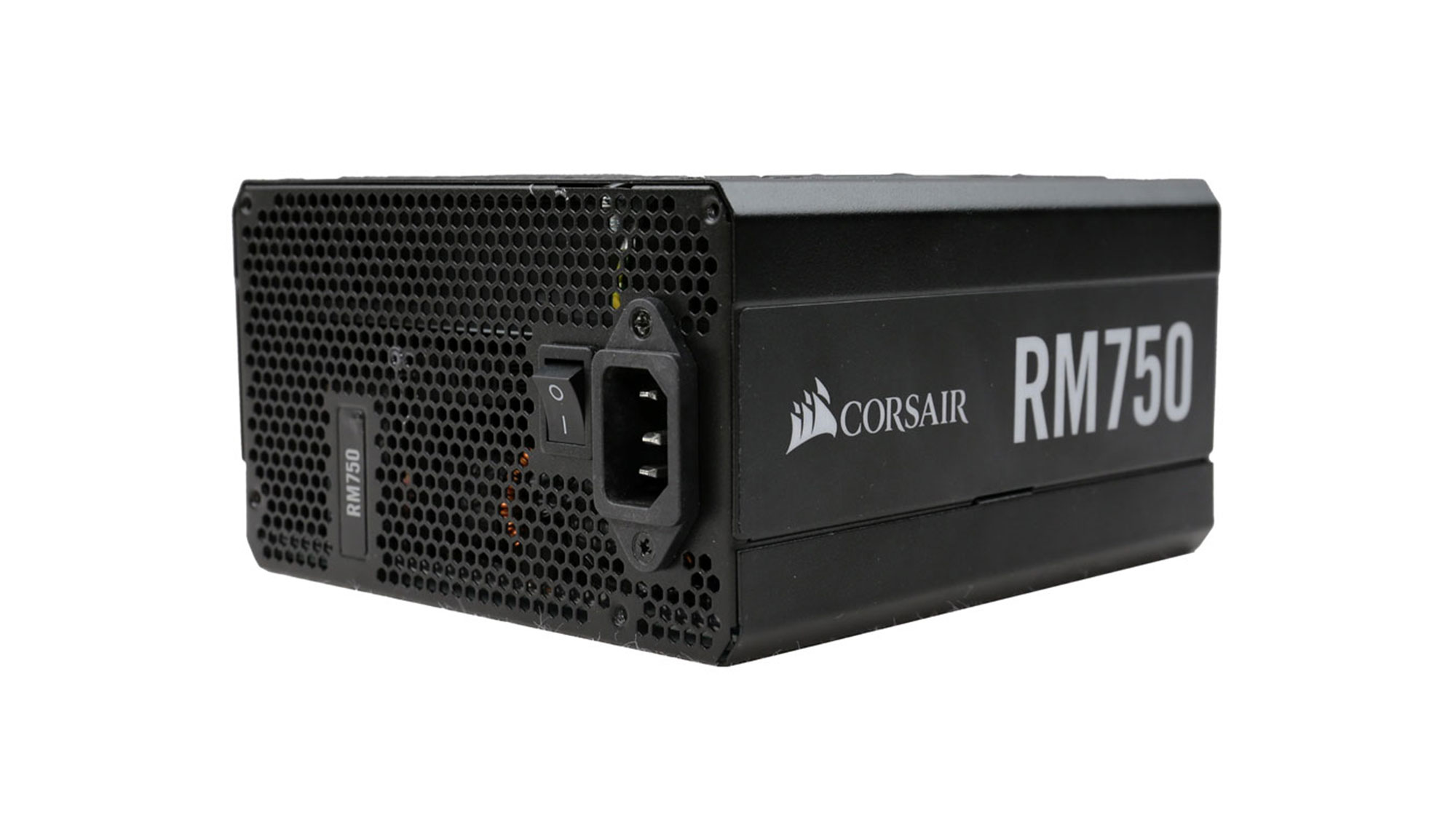Why you can trust Tom's Hardware
To learn more about our PSU tests and methodology, please check out How We Test Power Supply Units.
Primary Rails And 5VSB Load Regulation
The following charts show the main rails' voltage values recorded between a range of 40W up to the PSU's maximum specified load, along with the deviation (in percent). Tight regulation is an important consideration every time we review a power supply because it facilitates constant voltage levels despite varying loads. Tight load regulation also, among other factors, improves the system’s stability, especially under overclocked conditions and, at the same time, it applies less stress to the DC-DC converters that many system components utilize.

Results 1-8: Load Regulation







Load regulation is tight enough at 12V and pretty tight on the minor rails.
Hold-Up Time
Put simply; hold-up time is the amount of time that the system can continue to run without shutting down or rebooting during a power interruption.

Results 9-12: Hold-Up Time

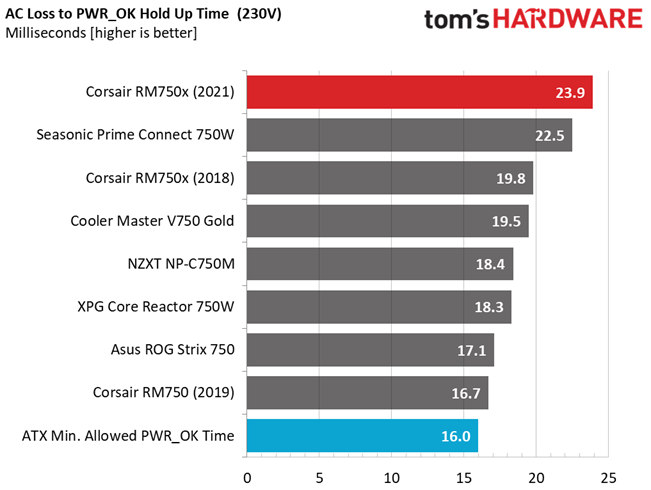

The hold-up is extra long at 26.6ms and the power ok signal is accurate.
Inrush Current
Inrush current, or switch-on surge, refers to the maximum, instantaneous input current drawn by an electrical device when it is first turned on. A large enough inrush current can cause circuit breakers and fuses to trip. It can also damage switches, relays, and bridge rectifiers. As a result, the lower the inrush current of a PSU right as it is turned on, the better.

Results 13-14: Inrush Current

Despite the large bulk caps, the NTC thermistor and relay combination do a good job, effectively lowering large inrush currents.
Get Tom's Hardware's best news and in-depth reviews, straight to your inbox.
Leakage Current
In layman's terms, leakage current is the unwanted transfer of energy from one circuit to another. In power supplies, it is the current flowing from the primary side to the ground or the chassis, which in the majority of cases is connected to the ground. For measuring leakage current, we use a GW Instek GPT-9904 electrical safety tester instrument.
The leakage current test is conducted at 110% of the DUT's rated voltage input (so for a 230-240V device, we should conduct the test with 253-264V input). The maximum acceptable limit of a leakage current is 3.5 mA and it is defined by the IEC-60950-1 regulation, ensuring that the current is low and will not harm any person coming in contact with the power supply's chassis.
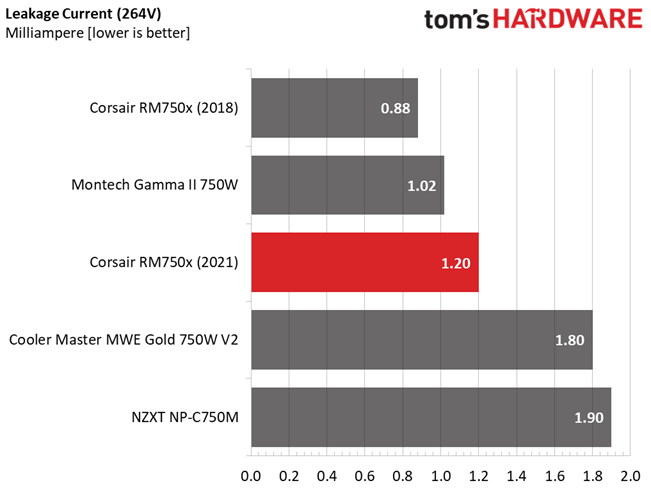
Leakage current is at low levels.
10-110% Load Tests
These tests reveal the PSU's load regulation and efficiency levels under high ambient temperatures. They also show how the fan speed profile behaves under increased operating temperatures.
| Test # | 12V | 5V | 3.3V | 5VSB | DC/AC (Watts) | Efficiency | Fan Speed (RPM) | PSU Noise (dB[A]) | Temps (In/Out) | PF/AC Volts |
| 1 | 4.426A | 1.981A | 2.003A | 0.994A | 74.964 | 86.350% | 0 | <6.0 | 45.68°C | 0.976 |
| 12.057V | 5.046V | 3.296V | 5.032V | 86.814 | 40.72°C | 115.17V | ||||
| 2 | 9.890A | 2.974A | 3.006A | 1.194A | 150.044 | 89.565% | 0 | <6.0 | 46.61°C | 0.991 |
| 12.047V | 5.042V | 3.294V | 5.027V | 167.526 | 40.96°C | 115.17V | ||||
| 3 | 15.726A | 3.473A | 3.509A | 1.394A | 225.052 | 91.126% | 0 | <6.0 | 48.28°C | 0.995 |
| 12.018V | 5.040V | 3.292V | 5.022V | 246.967 | 41.85°C | 115.17V | ||||
| 4 | 21.560A | 3.971A | 4.009A | 1.595A | 300.053 | 91.026% | 0 | <6.0 | 48.81°C | 0.995 |
| 12.006V | 5.038V | 3.291V | 5.018V | 329.636 | 41.94°C | 115.12V | ||||
| 5 | 27.021A | 4.964A | 5.015A | 1.795A | 374.621 | 90.381% | 361 | 7.2 | 42.58°C | 0.994 |
| 11.995V | 5.037V | 3.290V | 5.015V | 414.492 | 49.84°C | 115.11V | ||||
| 6 | 32.530A | 5.961A | 6.022A | 1.996A | 449.525 | 89.729% | 490 | 10.9 | 42.77°C | 0.995 |
| 11.980V | 5.034V | 3.289V | 5.011V | 500.982 | 50.70°C | 115.11V | ||||
| 7 | 38.080A | 6.958A | 7.027A | 2.198A | 524.855 | 88.989% | 712 | 21.0 | 43.51°C | 0.995 |
| 11.968V | 5.031V | 3.288V | 5.006V | 589.795 | 52.37°C | 115.11V | ||||
| 8 | 43.636A | 7.957A | 8.034A | 2.400A | 600.168 | 88.158% | 942 | 29.7 | 43.88°C | 0.996 |
| 11.957V | 5.028V | 3.286V | 5.002V | 680.789 | 53.14°C | 115.11V | ||||
| 9 | 49.566A | 8.461A | 8.525A | 2.400A | 674.727 | 87.338% | 1244 | 38.2 | 44.80°C | 0.996 |
| 11.948V | 5.025V | 3.284V | 5.000V | 772.544 | 54.75°C | 115.10V | ||||
| 10 | 55.308A | 8.964A | 9.048A | 3.009A | 749.982 | 86.381% | 1512 | 42.5 | 45.23°C | 0.997 |
| 11.938V | 5.022V | 3.282V | 4.986V | 868.225 | 55.74°C | 115.10V | ||||
| 11 | 61.658A | 8.969A | 9.052A | 3.011A | 825.230 | 85.461% | 1914 | 48.1 | 46.58°C | 0.997 |
| 11.929V | 5.019V | 3.281V | 4.982V | 965.625 | 57.40°C | 115.12V | ||||
| CL1 | 0.116A | 18.002A | 17.999A | 0.000A | 151.036 | 82.569% | 592 | 15.2 | 42.86°C | 0.992 |
| 12.024V | 5.026V | 3.287V | 5.076V | 182.921 | 49.79°C | 115.15V | ||||
| CL2 | 62.528A | 1.000A | 1.000A | 1.000A | 760.339 | 86.946% | 1907 | 48.4 | 45.44°C | 0.997 |
| 11.947V | 5.025V | 3.282V | 5.011V | 874.498 | 55.98°C | 115.20V |
The PSU's noise stays low until the 70% load test, despite the high operating temperatures. We had to apply full load to make the PSU's fan exceed 40 dBA, and in the overload test, it reached its maximum noise output, which is high at 48.1 dBA.
Even at light loads, the PF readings are high, showing that the APFC converter is up to the task. With a little higher efficiency, mostly at increased loads, we would be delighted.
20-80W Load Tests
In the following tests, we measure the PSU's efficiency at loads significantly lower than 10% of its maximum capacity (the lowest load the 80 PLUS standard measures). This is important for representing when a PC is idle with power-saving features turned on.
| Test # | 12V | 5V | 3.3V | 5VSB | DC/AC (Watts) | Efficiency | Fan Speed (RPM) | PSU Noise (dB[A]) | PF/AC Volts |
| 1 | 1.239A | 0.493A | 0.500A | 0.197A | 19.992 | 80.087% | 0 | <6.0 | 0.832 |
| 11.976V | 5.072V | 3.310V | 5.070V | 24.963 | 115.17V | ||||
| 2 | 2.478A | 0.990A | 1.000A | 0.397A | 39.983 | 85.115% | 0 | <6.0 | 0.937 |
| 11.977V | 5.051V | 3.299V | 5.047V | 46.975 | 115.17V | ||||
| 3 | 3.720A | 1.486A | 1.501A | 0.595A | 60.013 | 87.199% | 0 | <6.0 | 0.967 |
| 11.979V | 5.048V | 3.298V | 5.041V | 68.823 | 115.17V | ||||
| 4 | 4.925A | 1.982A | 2.000A | 0.795A | 79.963 | 86.916% | 0 | <6.0 | 0.978 |
| 12.054V | 5.046V | 3.296V | 5.036V | 92.000 | 115.17V |
The PSU's fan doesn't spin at light loads.
2% or 10W Load Test
Intel plans on raising the ante at efficiency levels under ultra-light loads. So from July 2020, the ATX spec will require 70% and higher efficiency with 115V input. The applied load is only 10W for PSUs with 500W and lower capacities, while for stronger units we dial 2% of their max-rated-capacity.
| Test # | 12V | 5V | 3.3V | 5VSB | DC/AC (Watts) | Efficiency | Fan Speed (RPM) | PSU Noise (dB[A]) | PF/AC Volts |
| 1 | 1.024A | 0.296A | 0.295A | 0.049A | 14.993 | 77.021% | 0 | <6.0 | 0.765 |
| 11.978V | 5.074V | 3.310V | 5.075V | 19.466 | 115.16V |
This platform achieves super-high efficiency with 2% load.
Efficiency & Power Factor
Next, we plotted a chart showing the PSU’s efficiency at low loads, and loads from 10 to 110% of its maximum rated capacity. The higher a PSU’s efficiency, the less energy goes wasted, leading to a reduced carbon footprint and lower electricity bills. The same goes for Power Factor.
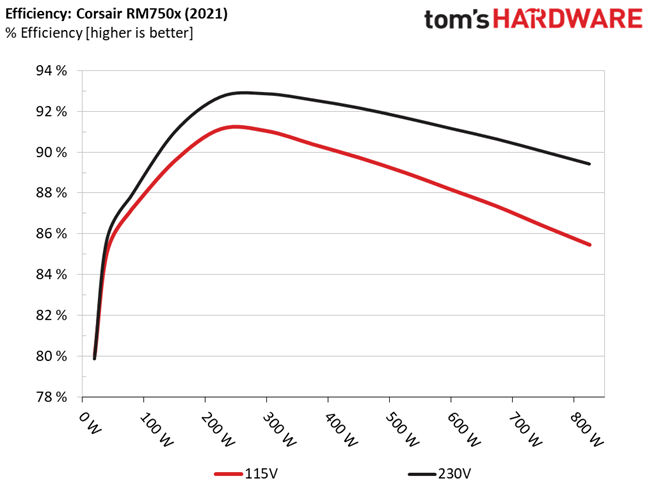
Results 15-18: Efficiency





The efficiency drop with 115V input is major, compared to 230V, especially at high loads. On the contrary, efficiency at light and super-light loads is sky-high.
5VSB Efficiency
| Test # | 5VSB | DC/AC (Watts) | Efficiency | PF/AC Volts |
| 1 | 0.100A | 0.504 | 75.789% | 0.067 |
| 5.043V | 0.665 | 115.17V | ||
| 2 | 0.250A | 1.260 | 78.261% | 0.149 |
| 5.040V | 1.610 | 115.17V | ||
| 3 | 0.550A | 2.769 | 78.979% | 0.262 |
| 5.034V | 3.506 | 115.17V | ||
| 4 | 1.000A | 5.026 | 78.482% | 0.350 |
| 5.025V | 6.404 | 115.16V | ||
| 5 | 1.500A | 7.524 | 78.326% | 0.400 |
| 5.015V | 9.606 | 115.15V | ||
| 6 | 3.000A | 14.959 | 77.296% | 0.466 |
| 4.986V | 19.353 | 115.15V |

Results 19-20: 5VSB Efficiency
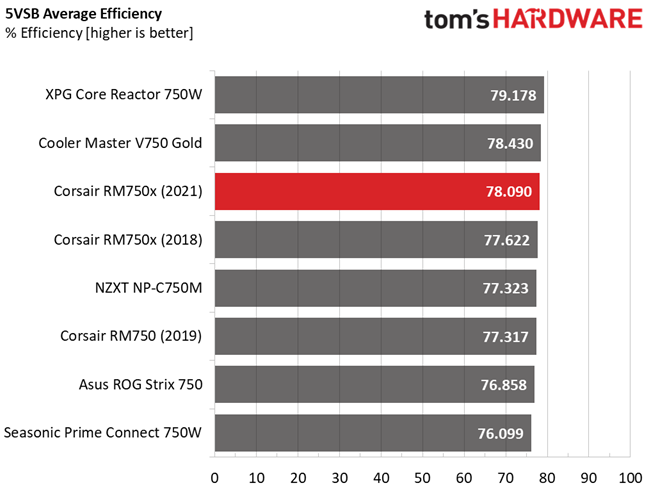
The 5VSB rail is efficient.
Power Consumption In Idle And Standby
| Mode | 12V | 5V | 3.3V | 5VSB | Watts | PF/AC Volts |
| Idle | 11.974V | 5.074V | 3.311V | 5.075V | 2.086 | 0.176 |
| 115.2V | ||||||
| Standby | 0.035 | 0.003 | ||||
| 115.2V |

Results 21-22: Vampire Power
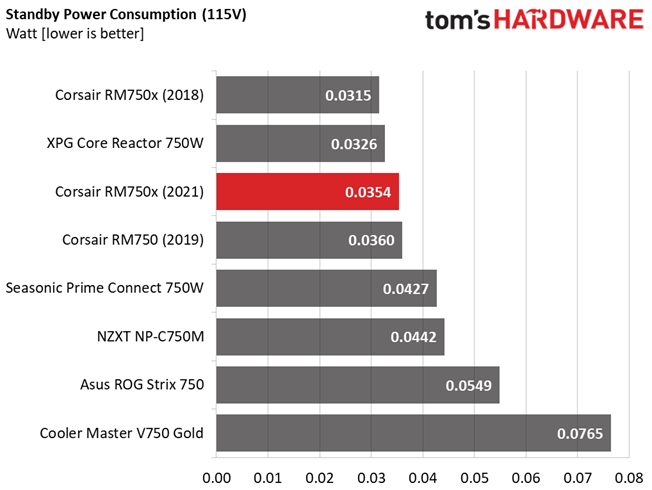
Vampire power is kept low with both voltage inputs, 115V and 230V.
Fan RPM, Delta Temperature, And Output Noise
All results are obtained between an ambient temperature of 37 to 47 degrees Celsius (98.6 to 116.6 degrees Fahrenheit).
The fan profile is not aggressive at high operating temperatures, allowing the ML fan to handle the thermal load effectively.
The following results were obtained at 30 to 32 degrees Celsius (86 to 89.6 degrees Fahrenheit) ambient temperature.
Because of the high load that we apply on the minor rails, the PSU's passive operation is short during these tests. Nonetheless, if you keep the load on the minor rails below 100W combined, which most likely will be the case unless you have tons of ARGB stuff in your system, the average noise output will be notably lower, up to 400W loads. At higher than 400W loads, the load on the minor rails doesn't seem to affect the fan speed profile.
MORE: Best Power Supplies
MORE: How We Test Power Supplies
MORE: All Power Supply Content
Current page: Load Regulation, Hold-Up Time, Inrush & Leakage Current, Efficiency and Noise
Prev Page Specifications and Part Analysis Next Page Protection Features, DC Power Sequencing, Cross-Load Tests and Infrared Images
Aris Mpitziopoulos is a contributing editor at Tom's Hardware, covering PSUs.
-
RAZ0RLIGHT Is there any reason why the 2021 revisions fan curve is so much more aggressive?Reply
This would be the perfect Gold PSU if they would have implemented the same fan curve as the older 2018 revision. -
I Reply
Disagree. It's still very quiet and I'd rather a tiny noise increase to reduce temps, increase lifespan.RAZ0RLIGHT said:Is there any reason why the 2021 revisions fan curve is so much more aggressive?
This would be the perfect Gold PSU if they would have implemented the same fan curve as the older 2018 revision.
This is probably what Corsair determined as well through wear testing, decided that not only would that reduce their warranty fulfillment costs but also improve customer satisfaction by having a longer lasting product.
If you don't care about the warranty, crack it open, put a few tens of ohms 2W resistor in series on the fan power lead, or just swap in a lower RPM fan, or mod the fan control circuit, or wear earplugs, or put the system under your desk, or get a cat plus 100 mice let loose all at once and you'll never even notice the very slight fan noise.
Besides, it's all a bit silly. If your system is pulling that many amps it's going to need its own more audible fans running anyway. For good lifespan. An internal, reward-facing exhaust, oriented fan is the least audible way to pull or push air through a system. -
Russll HelloReply
A few days ago I bought a Corsair RM750x (2021). Now the power supply consumes little (20-30%) because it works without a video card (AMD 5700G only).
The Aida64 and OCCT show voltage on rail +12V - 11.884V, and on rail +3.3VCC - 3.248V, on rail +5V - 4.980V (computer idle, browser only).
In the game, the voltage rises and shows on rail + 12V - 11.980V (maximum), and on rail + 3.3VCC - 3.264V (maximum), on rail + 5V - 5.020V.
Is this normal at all.?
There is no full 12V on rail + 12V, and no full 3.3V on rail + 3.3V..
Maybe I should return the product to the store.?
-
drivinfast247 Reply
Perfectly normal operation.Russll said:Hello
A few days ago I bought a Corsair RM750x (2021). Now the power supply consumes little (20-30%) because it works without a video card (AMD 5700G only).
The Aida64 and OCCT show voltage on rail +12V - 11.884V, and on rail +3.3VCC - 3.248V, on rail +5V - 4.980V (computer idle, browser only).
In the game, the voltage rises and shows on rail + 12V - 11.980V (maximum), and on rail + 3.3VCC - 3.264V (maximum), on rail + 5V - 5.020V.
Is this normal at all.?
There is no full 12V on rail + 12V, and no full 3.3V on rail + 3.3V..
Maybe I should return the product to the store.?
-
stateofdade Just purchased one of these based on this review. Thanks for the information and the deep dive into this PSU.Reply -
NoxMorbis I can't believe they used in cable caps. Shoddy and ridiculous. I have the 2018 RMX and I HATE those inline crap caps. I also looked at the soldering and found flux still stuck to the joints. Shoddy soldering is apparent. Geeze, what a quality control step down. I just think in line caps are fudging, although In know most do it.Reply

